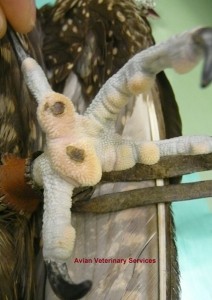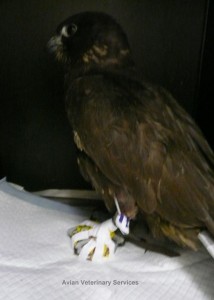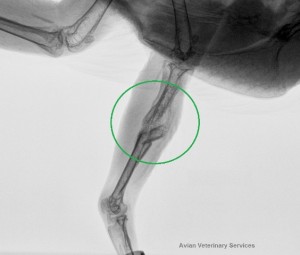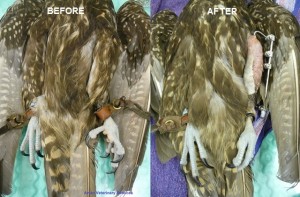







 Stella, a young Gyr falcon hybrid, presented to AVS last year with a case of bumblefoot in her left foot.
Stella, a young Gyr falcon hybrid, presented to AVS last year with a case of bumblefoot in her left foot.
Bumblefoot is essentially an inflammatory condition of the feet, with in most cases infection occurring secondary to a penetrating wound or more often pressure damage to the ball of the foot from either trauma or inappropriate perching, causing what are basically ‘bed sores’.
In all cases, as well as dealing with the localized inflammation/infection with a variety of medications and dressings, it is essential to work out and address the underlying cause.
In falcons it usually arises in overweight, inactive birds (possibly with poor skin quality related to sub-optimal nutrition) perched on too uniform a surface creating pressure points that over time may cause full thickness ulcers, allowing environmental bacteria to enter and run riot.
If not caught at an early stage via regular foot checks (at least weekly inspection of the ball of the foot), infection can ultimately eat away at bone, permanently damaging the architecture of the foot, that sadly in some cases results in euthanasia on humane grounds.
In Stella’s case the underlying cause was obvious. She had unfortunately broken her leg as a chick in the aviary but being a young rapidly growing bird the fracture had actually healed on its own, but at an odd angle resulting in a bent, rotated left leg.
Up to now she had been coping very well with her disability negotiating her aviary and using the foot well to perch and grasp food, however the now abnormal position of the leg was causing excessive pressure on the inside of the foot resulting in the observed lesions.
We couldn’t faults Stella’s nutrition and husbandry at this point with all perches covered in long leaf astroturf, which offers a cushioning effect to even large falcons, spreading their weight over numerous plastic filaments thus avoiding specific pressure points. Despite this however, her altered anatomy was now clearly starting to take its toll.
At this point, with foot deteriorating rapidly despite conservative management, we felt our only options were palliative/supportive care until the condition deteriorated to a point when euthanasia was warranted on humane grounds or to attempt surgical correction of the affected limb, thus recreating a normal weight bearing surface and in doing so, curing the bumblefoot.
Following discussion with the owner we elected to admit her for xrays to confirm surgery was even viable. The radiographs demonstrated the fracture to her tibiotarsus with the lower part of the leg rotating outwards.
Thankfully the remainder of the limb including joints appeared in good shape, so we decided to go ahead with surgery which involved re-fracturing the leg using a dental burr, realigning the limb into the correct position and applying a hybrid fixator.
This construct combines a stainless steel pin surgically implanted inside the hollow bone with a series of threaded external fixator pins screwed in from the outside and offers excellent bending and rotational stability allowing weight bearing almost immediately, thus encouraging early return to function.
We chose not to operate on the bumblefoot lesion at this point instead we fitted a foam shoe to alleviate the pressure on the sole. Thankfully with fracture healed and normal weight bearing restored, the bumblefoot completely resolved and I think you’ll agree she is now a fine looking falcon!
Interestingly, treating bumblefoot by such drastic measures of actually breaking a birds leg is nothing new.
The following paragraph is taken from a passage in a translation of an ~300 year old Persian treatise on falconry discussing the affliction we now call bumblefoot;
“If both feet are affected remove the jess (leg strap) from the worse of the two and break the tarsus bone. Keep the hawk in a dark room on a bed of cotton seed, in depth about four fingers breadth. The room must be so dark that the hawk cannot distinguish night from day. Once a day anoint her leg with clarified wax and mummy oil. It is not necessary to bind or set the leg. If your hawk is young, say of one or two moults, her leg will set in twenty days. If old say of ten or fifteen moults, it will take forty days. The younger the hawk, the sooner will the leg set. In this respect a hawk resembles man; for the broken bone of a five year old child will join in five days, of a ten year old child in ten days, of a fifty year old man in fifty days and of a ninety year old in ninety days. However a man of ninety years will, during those ninety days that he is laid up, contract so many other ailments that he will die.”
Extract from; Said Gah-I-Shaukati an Urdu Treatise on Falconry In The East by Sahabzadah Yar Muhammad Khan. Arranged edited by Humphrey ap Evans, from the translation of Lt.-Colonel E.S. Harcourt, M.C. London; Bernard Quaritch Ltd, 1968; p. 173
It sounds a bit drastic and we have yet to convince many clients of the merits of this particular treatment regime! It is interesting though that the principles of removing pressure from the sole of the foot as an integral part of therapy was clearly understood even way back then.
(Sincere thanks to Prof. Pat Redig at the University of Minnesota Raptor Center for supplying the above reference)
